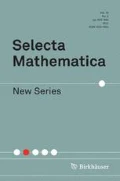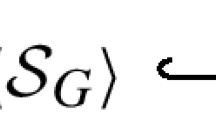Abstract
The goal of this paper is to classify fusion categories \({\mathcal {C}}\) which are \(\otimes \)-generated by an object X of Frobenius–Perron dimension less than 2, with the additional mild assumption that the adjoint subcategory of \({\mathcal {C}}\) is \(\otimes \)-generated by the object \(X\otimes X^*\). This classification has recently become accessible due to a result of Morrison and Snyder, showing that any such category must be a cyclic extension of a category of adjoint ADE type. Our main tools in this classification are the results of Etingof et al. (Quantum Topol 1(3);209–273, 2010. https://doi.org/10.4171/QT/6), classifying cyclic extensions of a given category in terms of data computed from the Brauer–Picard group, and Drinfeld centre of that category, and the results of Edie-Michell (Int. J. Math. 29(5):1850036, 2018. https://doi.org/10.1142/S0129167X18500362) which compute the Brauer–Picard group and Drinfeld centres of the categories of adjoint ADE type. Our classification includes the expected categories, constructed from cyclic groups and the categories of ADE type. More interestingly we have categories in our classification that are non-trivial de-equivariantizations of these expected categories. Most interesting of all, our classification includes three infinite families constructed from the exceptional quantum subgroups \({\mathcal {E}}_4\) of \({\mathcal {C}}( \mathfrak {sl}_4, 4)\), and \({\mathcal {E}}_{16,6}\) of \({\mathcal {C}}( \mathfrak {sl}_2, 16)\boxtimes {\mathcal {C}}( \mathfrak {sl}_3,6)\).
Similar content being viewed by others
References
Afzaly, N., Morrison, S., Penneys, D.: The classification of subfactors with index at most \(5\frac{1}{4}\) (2015). arXiv:1509.00038
Bigelow, S., Morrison, S., Peters, E., Snyder, N.: Constructing the extended Haagerup planar algebra. Acta Math. 209(1), 29–82 (2012). https://doi.org/10.1007/s11511-012-0081-7. arXiv:0909.4099
Bion-Nadal, J.: An example of a subfactor of the hyperfinite \({\rm II}_1\) factor whose principal graph invariant is the Coxeter graph \(E_6\). In: Current topics in operator algebras (Nara, 1990), pp. 104–113. World Scientific Publishing, River Edge, NJ (1991)
Bruguières, A., Natale, S.: Exact sequences of tensor categories. Int. Math. Res. Not. IMRN 24, 5644–5705 (2011). https://doi.org/10.1093/imrn/rnq294. arXiv:1006.0569
Coquereaux, R.: A quantum subgroup of \({A}_3\) at level \(4\). http://www.cpt.univ-mrs.fr/~coque/quantumfusion/FusionGraphsDataSubgroups/A3E4/QuantumSubgroupA3E4.html
Davydov, A., Müger, M., Nikshych, D., Ostrik, V.: The Witt group of non-degenerate braided fusion categories. J. Reine Angew. Math. 677, 135–177 (2013). arXiv:1009.2117
Edie-Michell, C.: Equivalences of graded categories (2017). arXiv:1711.00645
Edie-Michell, C.: The Brauer–Picard groups of fusion categories coming from the \(ADE\) subfactors. Int. J. Math. 29(5), 1850036 (2018). https://doi.org/10.1142/S0129167X18500362. arXiv:1709.04721
Edie-Michell, C.: The classification of categories generated by an object of small dimension. PhD thesis, Australian National University (2018). https://openresearch-repository.anu.edu.au/handle/1885/146634
Edie-Michell, C.: A complete classification of pivotal fusion categories \(\otimes \)-generated by an object of dimension \(\frac{1 +\sqrt{5}}{2}\), (2019). arXiv:1904.08909
Edie-Michell, C., Morrison, S.: A survey of categories with \({A}_n\) fusion rules (2017). arXiv:1710.07362
Etingof, P., Nikshych, D., Ostrik, V.: Fusion categories and homotopy theory. Quantum Topol. 1(3), 209–273 (2010). https://doi.org/10.4171/QT/6. (with an appendix by Ehud Meir), arXiv:0909.3140
Etingof, P., Nikshych, D., Ostrik, V.: On fusion categories. Ann. of Math. (2) 162(2), 581–642 (2005). https://doi.org/10.4007/annals.2005.162.581. arXiv:math.QA/0203060
Etingof, P., Ostrik, V.: On semisimplification of tensor categories (2018). arXiv:1801.04409
Fröhlich, J., Kerler, T.: Quantum groups, quantum categories and quantum field theory. Lecture Notes in Mathematics, vol. 1542. Springer, Berlin (1993)
Greenough, J.: Monoidal 2-structure of bimodule categories. J. Algebra 324(8), 1818–1859 (2010). https://doi.org/10.1016/j.jalgebra.2010.06.018. arXiv:0911.4979
Grossman, P., Snyder, N.: Quantum subgroups of the Haagerup fusion categories. Commun. Math. Phys. 311(3), 617–643 (2012). https://doi.org/10.1007/s00220-012-1427-x. arXiv:1102.2631
Grossman, P., Snyder, N.: The Brauer–Picard group of the Asaeda–Haagerup fusion categories. Trans. Am. Math. Soc. 368(4), 2289–2331 (2016). https://doi.org/10.1090/tran/6364. arXiv:1202.4396
Izumi, M.: Application of fusion rules to classification of subfactors. Publ. Res. Inst. Math. Sci. 27(6), 953–994 (1991). https://doi.org/10.2977/prims/1195169007
Izumi, M.: On flatness of the Coxeter graph \(E_8\). Pac. J. Math. 166(2), 305–327 (1994). euclid.pjm/1102621140
Izumi, M.: The structure of sectors associated with Longo–Rehren inclusions. II. Examples. Rev. Math. Phys. 13(5), 603–674 (2001). https://doi.org/10.1142/S0129055X01000818
Jones, V.F.R.: The annular structure of subfactors. In: Ghys, E. (ed.) Essays on geometry and related topics, Vol. 1, 2, volume 38 of Monographies de L’Enseignement mathématique. Enseignement mathématique, Geneva (2001)
Kawahigashi, Y.: On flatness of Ocneanu’s connections on the Dynkin diagrams and classification of subfactors. J. Funct. Anal. 127(1), 63–107 (1995). https://doi.org/10.1006/jfan.1995.1003
Kirillov Jr., A., Ostrik, V.: On a \(q\)-analogue of the McKay correspondence and the ADE classification of \(\mathfrak{s}\mathfrak{l}_2\) conformal field theories. Adv. Math. 171(2), 183–227 (2002). https://doi.org/10.1006/aima.2002.2072. arXiv:math.QA/0101219
Larson, H.K.: Pseudo-unitary non-self-dual fusion categories of rank 4. J. Algebra 415, 184–213 (2014). https://doi.org/10.1016/j.jalgebra.2014.05.032. arXiv:1401.1879
Morrison, S., Peters, E., Snyder, N.: Skein theory for the \(\cal{D} _{2n}\) planar algebras. J. Pure Appl. Algebra 214(2), 117–139 (2010). https://doi.org/10.1016/j.jpaa.2009.04.010. arXiv:0808.0764
Morrison, S., Peters, E., Snyder, N.: Categories generated by a trivalent vertex. Selecta Math. (N.S.) 23(2), 817–868 (2017). https://doi.org/10.1007/s00029-016-0240-3. arXiv:1501.06869
Ng, S.-H., Schauenburg, P.: Frobenius–Schur indicators and exponents of spherical categories. Adv. Math. 211(1), 34–71 (2007). https://doi.org/10.1016/j.aim.2006.07.017. arXiv:math/0601012
Ostrik, V.: Module categories, weak Hopf algebras and modular invariants. Transform. Groups 8(2), 177–206 (2003). arXiv:math/0111139
Ostrik, V.: Pivotal fusion categories of rank 3 (2013). (with an Appendix written jointly with Dmitri Nikshych), arXiv:1309.4822
Quinn, F.: Group categories and their field theories. In: Proceedings of the Kirbyfest (Berkeley, CA, 1998), volume 2 of Geometry and Topology Monographs, pp. 407–453. Geometry and Topology Publications, Coventry (1999). arXiv:math/9811047. https://doi.org/10.2140/gtm.1999.2.407
Schopieray, A.: Level bounds for exceptional quantum subgroups in rank two. Int. J. Math. 29(5), 1850034, 33 (2018). https://doi.org/10.1142/S0129167X18500349. arXiv:1706.02265
Xu, F.: New braided endomorphisms from conformal inclusions. Commun. Math. Phys. 192(2), 349–403 (1998). https://doi.org/10.1007/s002200050302
Acknowledgements
The author is grateful to many people for their help with this paper. This paper is an adaptation of the authors PhD Thesis, supervised by Scott Morrison who provided invaluable support. I would also like to thank Pinhas Grossman, Corey Jones, and Noah Synder for interesting discussions, and Marcel Bischoff, Victor Ostrik, and Eric Rowell for their comments on the Thesis version of this paper.
This research was supported by an Australian Government Research Training Program (RTP) Scholarship. The author was partially supported by the Discovery Project ’Subfactors and symmetries’ DP140100732 and ’Low dimensional categories’ DP160103479.
Author information
Authors and Affiliations
Corresponding author
Additional information
Publisher's Note
Springer Nature remains neutral with regard to jurisdictional claims in published maps and institutional affiliations.
Appendix A. Fusion Rules for the categories \({\mathcal {E}}^{(n)}_4\) and \({\mathcal {E}}^{(n,\pm )}_{16,6}\)
Appendix A. Fusion Rules for the categories \({\mathcal {E}}^{(n)}_4\) and \({\mathcal {E}}^{(n,\pm )}_{16,6}\)
In this appendix we compute the fusion rules for the categories \({\mathcal {E}}^{(n)}_4\) and \({\mathcal {E}}^{(n,\pm )}_{16,6}\). We begin with the \({\mathcal {E}}^{(n,\pm )}_{16,6}\) case, which is conceptually easier, but computationally harder.
Recall from Lemma 3.18 that the categories \({\mathcal {E}}^{(n,\pm )}_{16,6}\) are \( {\mathbb {Z}}_{6}\)-graded extensions of \({\text {Ad}}(D_{10}^{(n)})\). The 3-graded piece under this grading is either the bimodule \(D_{10}^{\text {odd}}\) or \(_{P\leftrightarrow Q}D_{10}^{\text {odd}}\). Thus \({\mathcal {E}}^{(n,\pm )}_{16,6}\) has a \( {\mathbb {Z}}_{2}\)-graded subcategory equivalent to \(D_{10}^{(\pm n , \pm )}\), and \({\mathcal {E}}^{n,m,\pm }_{16,6}\) is thus a \( {\mathbb {Z}}_{3}\)-graded extension of \(D_{10}^{(\pm n , \pm )}\).
The Brauer–Picard group of \(D_{10}^{(\pm n , \pm )}\) was computed in [8], and the only order 3 bimodules are \(_{P\leftrightarrow Q}E_7\) and \(_{P\leftrightarrow Q}{\overline{E}}_7\). Thus, as a \( {\mathbb {Z}}_{3}\)-graded extension of \(D_{10}^{(\pm n , \pm )}\), the 1 and 2 graded pieces consist of these two bimodules. This gives us fusion rules for tensoring a \(D_{10}\) object with either a \(_{P\leftrightarrow Q}E_7\) object, or a \(_{P\leftrightarrow Q}\overline{E_7}\) object.
We now aim to determine how two \(_{P\leftrightarrow Q}E_7\) objects tensor. Due to the grading, the tensor of two such object must live in the \(_{P\leftrightarrow Q}\overline{E_7}\) piece. Let X and Y be \(_{P\leftrightarrow Q}E_7\) objects, and Z a \(D_{10}\) object, then associativity of the fusion rules gives us that
Along with the fact that tensor product must preserve Frobenius–Perron dimensions, this allows us to completely determine the fusion rules for tensoring two objects in the 1-graded piece.
By considering Frobenius–Perron dimensions, and the grading of the category, we can completely determine the dual of each object. Each \(D_{10}\) object is self-dual, and each \(_{P\leftrightarrow Q}E_7\) is dual to the unique object in the \(_{P\leftrightarrow Q}\overline{E_7}\) piece with the same Frobenius–Perron dimension.
Finally, an application of Frobenius reciprocity gives fusion rules for the entire category. The full fusion rules for the categories \({\mathcal {E}}^{(n,\pm )}_{16,6}\) can be found at the authors website http://cainedie.com/E166fusion.txt. To save space we only present in Fig. 1 the fusion graph for the \(\otimes \)-generating object of Frobenius–Perron dimension \(2\cos (\frac{\pi }{18})\), living in the 1-graded piece.
We now compute the \({\mathcal {E}}^{(n)}_4\) case. Recall the category \({\mathcal {E}}^{(n)}_4\) is a \( {\mathbb {Z}}_{4}\)-graded extension of a category of adjoint \(A_7\) type, with the 1, 2, and 3 graded pieces being the bimodules \(_{f^{(2)} \leftrightarrow f^{(4)} }A_7^\text {odd}\), \(D_5^\text {even}\), and \(_{f^{(2)} \leftrightarrow f^{(4)} }D_5^\text {even}\) respectively.
From [5] we know the Frobneius–Perron dimensions of the 12 simple objects of \({\mathcal {E}}^{(n)}_4\). They are
With the first 4 objects living in the 0-graded piece, the next 3 objects living in the 1 graded piece, the next 2 objects living in the 2 graded piece, and the final 3 objects living in the 3-graded piece. For simplicity we call the 12 objects of this category the numbers \({\mathbf {1}}\) through \(\mathbf {12}\).
Simply by considering Frobenius–Perron dimensions, along with the associativity check from the \({\mathcal {E}}_{16,6}\) case, allows us to completely determine fusion rules for all objects apart from fusion between the objects 5, 6 and 10, 11. Here we get four possible fusion rules:
Fusion rule | \({\mathbf {5}}\otimes \mathbf {10}\) | \({\mathbf {5}}\otimes \mathbf {11}\) | \({\mathbf {6}}\otimes \mathbf {10}\) | \({\mathbf {6}}\otimes \mathbf {11}\) |
|---|---|---|---|---|
1 | \( {\mathbf {1}} \oplus {\mathbf {2}} \) | \( {\mathbf {3}} \oplus {\mathbf {4}}\) | \({\mathbf {3}} \oplus {\mathbf {4}} \) | \({\mathbf {1}} \oplus {\mathbf {2}}\) |
2 | \( {\mathbf {1}}\oplus {\mathbf {3}} \) | \( {\mathbf {2}} \oplus {\mathbf {4}}\) | \({\mathbf {2}} \oplus {\mathbf {4}} \) | \({\mathbf {1}} \oplus {\mathbf {3}}\) |
3 | \( {\mathbf {3}} \oplus {\mathbf {4}} \) | \( {\mathbf {1}} \oplus {\mathbf {2}}\) | \({\mathbf {1}} \oplus {\mathbf {2}} \) | \({\mathbf {3}} \oplus {\mathbf {4}}\) |
3 | \( {\mathbf {2}} \oplus {\mathbf {4}} \) | \( {\mathbf {1}} \oplus {\mathbf {3}}\) | \({\mathbf {1}} \oplus {\mathbf {3}} \) | \({\mathbf {2}} \oplus {\mathbf {4}}\) |
However a direct computation shows each of these four fusion rules are isomorphic. Thus we can completely determine the fusion rules for the categories \({\mathcal {E}}^{(n)}_4\). Again we only present the fusion graph for the generating object \({\mathbf {5}}\) of Frobenius–Perron dimension \(\sqrt{2+\sqrt{2}}\) in Fig. 2. Full fusion rules can be found at the authors website http://cainedie.com/E4fusion.txt.
Using the fusion rules of \({\mathcal {E}}_4\), we can directly compute the fusion ring automorphisms.
Lemma A.1
There exist three non-trivial fusion ring automorphisms of \({\mathcal {E}}^{(n)}_4\) given by
and
While this Lemma may seem out of place, it proves important in showing that the categories \({\mathcal {E}}_4^{(n)}\) realises two different \( {\mathbb {Z}}_{4}\)-graded extensions of the category \({\text {Ad}}(A_7^{(n)})\).
Rights and permissions
About this article
Cite this article
Edie-Michell, C. Classifying fusion categories \(\otimes \)-generated by an object of small Frobenius–Perron dimension. Sel. Math. New Ser. 26, 24 (2020). https://doi.org/10.1007/s00029-020-0550-3
Published:
DOI: https://doi.org/10.1007/s00029-020-0550-3






